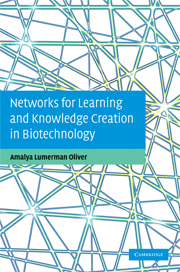Book contents
- Frontmatter
- Contents
- List of figures
- List of tables
- Acknowledgements
- Introduction
- 1 Networks, collaborations, and learning and knowledge creation
- 2 The biotechnology industry through the lenses of organizational and networks scholarship
- 3 New organizational forms for knowledge creation in biotechnology
- 4 Scientific entrepreneurship
- 5 Science and discoveries in the context of private and public knowledge creation and learning
- 6 The search for university–industry collaborations: linear and chaotic networking processes
- 7 Trust in collaborations and the social structure of academic research
- 8 Organizational learning and strategic alliances: recombination and duality of competition and collaboration
- 9 Further directions for understanding interorganizational collaborations and learning
- References
- Index
6 - The search for university–industry collaborations: linear and chaotic networking processes
Published online by Cambridge University Press: 04 July 2009
- Frontmatter
- Contents
- List of figures
- List of tables
- Acknowledgements
- Introduction
- 1 Networks, collaborations, and learning and knowledge creation
- 2 The biotechnology industry through the lenses of organizational and networks scholarship
- 3 New organizational forms for knowledge creation in biotechnology
- 4 Scientific entrepreneurship
- 5 Science and discoveries in the context of private and public knowledge creation and learning
- 6 The search for university–industry collaborations: linear and chaotic networking processes
- 7 Trust in collaborations and the social structure of academic research
- 8 Organizational learning and strategic alliances: recombination and duality of competition and collaboration
- 9 Further directions for understanding interorganizational collaborations and learning
- References
- Index
Summary
Introduction
Recent organizational research focusses on issues of learning in networks (Oliver 2001; Beckman & Haunschild 2002; Hagedoorn & Duysters 2003; Hardy, Phillips & Lawrence 2003), all testing the degree to which organizational knowledge or decisions are based on learning gained through network-based exchanges. Since issues of technology-transfer and university–industry collaborations take an important role in explaining some of the learning features in knowledge intensive industries (Liebeskind et al. 1996; Powell, Koput & Smith-Doerr 1996; Owen-Smith et al. 2002), attention has been given to the issues of learning and knowledge-transfer across the different institutional contexts of academia and industry.
It is now well understood that biotechnology-related products are developed within interorganizational networks of universities, dedicated biotechnology firms, and large pharmaceutical firms (Liebeskind et al. 1996; Liebeskind & Oliver 1998; Oliver & Liebeskind 1998; Powell, Koput & Smith-Doerr 1996). The important role played by universities in biotechnology product development (Zucker, Darby & Brewer 1998) requires the establishment of collaborations between universities and biotechnology firms through which basic and applied science are transferred into products. These symbiotic interrelations result from the constant interdependence between the two types of institutions (Liebeskind et al. 1996; Oliver & Montgomery 2000). The motivations of the participants in university–industry alliances vary from needs for funding academic research to scientific reputation and better access to corporate R&D consulting options (Nelkin, Nelson & Kiernan 1987).
- Type
- Chapter
- Information
- Networks for Learning and Knowledge Creation in Biotechnology , pp. 140 - 168Publisher: Cambridge University PressPrint publication year: 2009



